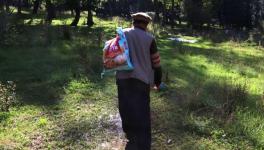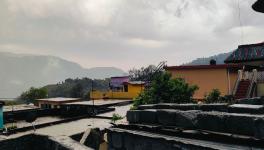J&K: Subterfuge in the Form of Land Law Amendments will Rob Locals of their Foremost Asset
File Photo.
Few had imagined that the so-called integration of Jammu and Kashmir after August 5, 2019 and the scrapping of Articles 370 & 35 A of the Constitution, would mean its people losing land. Before one delves into the intention of the amendments brought to the land laws in the erstwhile state on October 27, it is pertinent to mention and understand who will buy land in J&K.
In Kashmir, the majority of Kashmiri Pandits have moved out and have not been able to go back. Given the situation, what does allowing for the sale of land in the region mean? In Jammu, there is more resentment than in the Kashmir Valley as the protection given to people in this region is now gone, and they risk becoming more vulnerable to losing their land than the people residing in the valley. While few will venture into the Valley to buy land, Jammu will be more exposed to such land sales.
The ‘Gupkar Alliance’, comprising the major non-BJP political parties of the region, have condemned this decision by the Centre, calling it “J&K for sale.” The parties have expressed apprehension that the government intends on changing the demography of the region, especially the Kashmir valley. However, the moot point is: Who will buy land there? It is believed that in the given situation, some ex-servicemen will be made to live in localities within the valley which will be adequately facilitated by the government. When and how, we will have to wait and see!
What does this amendment mean however? In simplistic terms, it means that any citizen of India, not necessarily a permanent resident of J&K, can now purchase land in the region and settle down. As the BJP’s IT cell would say, the argument is that when land can be bought in any other part of the country, then why not in J&K? It sounds quite democratic. However, in reality, it is against the democratic process which led to the creation of such laws, not just in J&K but in several other states.
It was in 1927 and 1932 that two notifications were brought out by the then Maharaja, Hari Singh, on the incessant pressure from the Dogras(Rajputs) and the Kashmiri Pandits (both were more exposed and aware of land-use value) to protect their land and the identity of the J&K people, including jobs. ‘Kashmir for the Kashmiris’ was the slogan of the KPs and the Dogras, and the then sovereign ruler, Hari Singh, promulgated these two notifications to protect land & other rights of the people of the region. The king got a statutory order passed which defined hereditary as a state subject and recognised the “hereditary state subject’s” exclusive rights of appointment in government departments and in the purchase and sale of land, says ‘Kashmir in Conflict’, a book by Victoria Schofield. Hence, the land rights to the natives were accrued even before we were independent.
Not to allow non-residents of a particular state to purchase land in is not restricted to the special status accorded to J&K. The idea also evolved through the peasant movements with slogans like ‘land to the tiller’. Sheikh Abdullah, former chief minister and father of Farooq Abdullah, was instrumental in effecting land reforms in J&K and empowering the peasants with entitlement to land. It was the Constituent Assembly of J&K that passed The Big Land Estates Abolition Act, 1950, which acted on ‘land to the tiller’. It was during this process that slogans emerged that the land once handed over to the peasant must also be secured from ‘land sharks’. The fear was that they would create a newer form of land relations instead of the landlord-peasant relationship.
Himachal is a Shining Example
Himachal Pradesh is another vibrant example and continues to protect the land secured by the peasants, either through land reforms and tenancy acts or through the land distribution in the 1970s where the government provided ‘new land’(nau taur) to all landless peasants. A majority of beneficiaries were Scheduled Castes and other backward sections of the peasantry. Unlike in J&K, where a permanent resident under the previous law was empowered to purchase land in the state – in Himachal Pradesh – even if someone has been a resident of the state (permanently) for the last 100 years, they were still not entitled to purchase land in the state and the law remains the same.
To purchase land in the state of Himachal Pradesh one must be an agriculturist. Just the time period of the stay does not qualify one to be able to buy land. While there are counter-arguments to the idea, the fact remains that when the state was conceived by the visionary Dr Y.S. Parmar – its first chief minister – during various debates in the Vidhan Sabha, he gave reasons for protecting land entitlements for the peasants. The foremost was that if the state has to sustain itself then its basic asset must remain with the peasants.
A few years ago, the neighbouring state of Uttrakhand promulgated laws to restrict land sale to non-state domiciles. However, prior to that, it was a free ride for everyone. The result, according to the late Professor R.S. Tolia, the former chief secretary of the state, was that more than 50% of its assets in the form of land is with non-state subjects.
The idea also sheds light on the overall development indices of both, J&K and Himachal Pradesh. I remember when the state of Uttrakhand was carved out and I used to visit the state frequently. For the majority of state leaders of all political parties, the model of development for a hilly state was that of Himachal Pradesh. As part of the model, securing land rights for the people and not allowing non-agriculturists to buy land played a major role.
The protection of land does not just end there. Even within Himachal, in the two districts of Lahaul & Spiti and Kinnaur, even an agriculturist from Himachal is not entitled to purchase land.
Protection of land laws while safeguarding the interests of the peasantry continue to exist. What will happen in Leh now, we do not know. The residents of Ladakh are demanding the protection of their land rights and still, ambiguity exists on whether they be under the Sixth Schedule or not. One of the driving forces to allow easy sales and purchase of land in the region is the huge potential it has for the generation of photovoltaic energy. With large giants like the Adanis in the fray, it is not a surprise that land laws could be amended even in this region.
One of the arguments being made by well-meaning people is that by depressing such sale of land and not allowing it to be sold is actually robbing peasants of the state of their legitimate gains. It is being said that the money would have flowed to them had there been an open sale of land. But the fact remains that in a capitalist developmental model, land sharks are the ones who have amassed massive wealth and the peasants, who later become landless, are its worst sufferers.
The road map of such a development model speaks volumes of the changes in the lifestyle of the peasantry. J&K’s peasants are known to earn well from the harvest of saffron and apples. In Himachal, the apple economy is more than Rs 5,000 crore annually and the off-season vegetables add another two thousand crores to that.
The amendments in the land laws may seem inconsequential at the moment, but as climate change and pollution in the bigger cities makes living difficult, large investments are bound to take place into these three states. Allowing large land sharks to play their game will ruin the gains and advancement made by the peasantry and their children, who now are part of the larger middle class in small towns.
The alternative must be to ensure that there is a priority set for equitable development of the state and its people. The loss of land will end up in suffering for the people and the state will also lose gains made in the past.
The writer is former deputy mayor of Shimla. The views are personal.
Get the latest reports & analysis with people's perspective on Protests, movements & deep analytical videos, discussions of the current affairs in your Telegram app. Subscribe to NewsClick's Telegram channel & get Real-Time updates on stories, as they get published on our website.
























